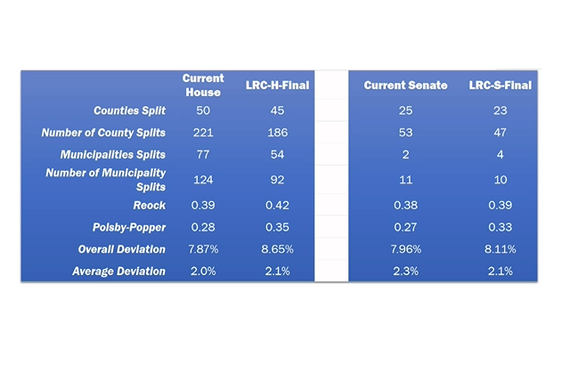Analyzing PA's New Maps
In March 2022, Pennsylvania finalized its congressional and legislative election maps. Here's how they stack up.
Congressional Map
On February 23rd, 2022, the PA Supreme Court chose the so-called "Carter Map" from among 13 different submissions to the court.
“While we are disappointed that the Supreme Court did not select the Pennsylvania Citizens’ Map, we are encouraged that the map they selected is an improvement on the map picked by the Commonwealth Court,” said David Thornburgh, DTL's chair. “By the metrics, it is a fair map that meets the constitutional standards.”
The plan, proposed by a group of Pennsylvania voters represented by a national Democratic redistricting committee, was among the most effective maps before the court at limiting partisan bias. Its lawyers also touted its "least-change" approach, where it attempted to minimize changes from the 2018 congressional map.
The Carter map includes a few more splits than the map recommended by Republican Commonwealth Court judge Patricia McCullough (House Bill 2146, which was passed out of the General Assembly and vetoed by Gov. Wolf), while being slightly more compact. Taken with superior partisan fairness metrics, the Carter map was a reasonable selection for the Court.

A comment on process
As with House Bill 2146 recommended by the Commonwealth Court, this is not a map drawn with extensive citizen engagement. Hopefully, despite the map being sound on the metrics, this subpar level of citizen engagement gives Pennsylvanians renewed energy to create a standard in which voters drive how the Commonwealth draws the lines in future redistricting cycles.
State House and Senate Maps
Note: On Feb. 4, the Legislative Reapportionment Commission released and voted 4-1 to approve final State House and State Senate voting maps for Pennsylvania for the next decade. Notably, this was a bipartisan vote, with Senate Majority Leader Kim Ward (R-Westmoreland) joining Minority Leader Joanna McClinton (D-Philadelphia) and Senate Minority Leader Jay Costa (D–Allegheny) and Chair Mark Nordenberg in voting for the maps.
How do PA's new legislative maps stack up to the current districts? It appears they are better almost across the board. In both the House and Senate, there are fewer splits across political divisions. Districts are more compact. Overall population deviation between the largest and smallest district is slightly larger, but the average deviation is about the same.

There was a great deal of discussion before the vote about racial equity in the maps. There are now 7 districts in the House and 2 in the Senate where there is not an incumbent and in which non-white voters make up a majority of the district. In the maps drawn in 2012, there were 28 districts in which non-white voters made up at least 35% of the voting-age population. The new maps contain 44 such districts. On the Senate side, the maps drawn in 2012 had 5 districts; the new maps contain 10.
Lastly, the Philadelphia Inquirer summarized the overall partisan impact of these maps. Neither map appears to unduly advantage one party over another. “The new maps still slightly favor Republicans but are significantly closer to evenly split than the current maps,” they write.
On March 16, 2022, the maps were finalized when the PA Supreme Court (SCOPA) denied nine challenges to the plans. These maps are now in place through the 2030 election cycle.
A note on the LRC's process
Lastly, a note of thanks to Chairman Nordenberg and his staff for the work they did to shepherd through a transparent, disciplined, and fair process. When Draw the Lines advocated for a truly independent chairperson to serve on the LRC almost a year ago, Nordenberg’s leadership was what we had in mind. Better process does in fact produce a better result, and the LRC process was disciplined, transparent, and responsive. We appreciate his team’s service to the citizens of the Commonwealth.